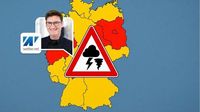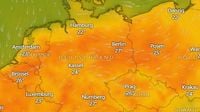Germany is bracing for a dramatic weather shift this weekend, as severe thunderstorms and a significant drop in temperatures are expected to sweep across the country. Following a period of early summer warmth with temperatures soaring up to 30 degrees Celsius, the arrival of a polar front will bring heavy rain, hail, and even the possibility of tornadoes.
On Friday, May 2, 2025, the idyllic weather that had many enjoying outdoor activities was abruptly interrupted by the forecast of severe weather. Regions particularly affected include North Rhine-Westphalia, southern Lower Saxony, Brandenburg, and Saxony, where powerful thunderstorms began to develop, bringing with them heavy rain, small hail, and squalls. Meteorologists warned that the conditions were ripe for supercells—highly organized thunderstorms that can produce extreme weather, including tornadoes.
Dr. Markus Übel from the German Weather Service (DWD) noted, "The weather situation is changing, and the sunny and warm weather is coming to an abrupt end from the north in the coming days." As the polar air flows into Germany, it meets subtropical warm air, creating the potential for severe thunderstorms across the country.
By Saturday, May 3, the storm front will extend from Aachen in the west to Halle and Leipzig in the east, with particularly dangerous conditions expected around Kassel and between Göttingen and Erfurt. The German Weather Service predicts that heavy rain could accumulate to 30 liters per square meter in some areas, with the possibility of even higher amounts. Hailstones could reach sizes comparable to table tennis balls, measuring up to 3 centimeters in diameter.
As the day progresses, conditions are expected to worsen, with meteorologists warning of hurricane-force gusts and the risk of local flooding. The storms are forecasted to intensify, particularly in the central regions of Germany, where the air is warm and humid, creating ideal conditions for severe weather development. Dr. Karsten Brandt, a meteorologist at Donnerwetter.de, explained, "The cold front will lie across Germany, and in these areas, it will get really uncomfortable. The thunderstorms can extend to the Alps in the south, and we are also seeing a 'blood rain' alert due to Sahara dust in the atmosphere, which can mix with the rain and create a reddish hue."
Sunday, May 4, will not bring respite, as the weather remains unstable, especially in the south. Persistent rain is expected in the southeastern regions, particularly in the Alpine areas, where the combination of already saturated soils and heavy rainfall could lead to local flooding. Temperatures will plummet, with highs only reaching between 10 and 12 degrees Celsius in many areas, a stark contrast to the previous week’s summer-like conditions.
In fact, temperatures will drop dramatically, with meteorologists predicting lows of 5 to 10 degrees by Monday, May 5. The sudden shift from summer warmth to winter-like conditions is being described as one of the most extreme weather changes in recent years. Dr. Dominik Jung from wetter.net emphasized, "This is a weather change like something out of a textbook—blitzartig, heftig, mit voller Wucht," referring to the abruptness and intensity of the weather shift.
As the severe weather unfolds, residents are advised to remain vigilant and heed weather warnings. Those planning outdoor activities should reconsider their plans, as the storms pose a significant danger. The DWD has issued alerts advising people to seek shelter in sturdy buildings or vehicles when thunderstorms approach, and to avoid open areas and tall structures.
This weekend's weather chaos serves as a reminder of nature's unpredictability and the importance of preparedness. With the potential for severe thunderstorms, hail, and tornadoes, it is crucial for individuals to stay informed through weather apps and local services that provide timely updates on developing conditions.
As the storms pass, the following week is expected to see a gradual warming trend, but for now, Germany must brace for the impacts of this weather upheaval. The combination of high temperatures preceding the storms and the subsequent cold front highlights the volatile nature of spring weather in Germany, where conditions can shift from pleasant to perilous in a matter of hours.






